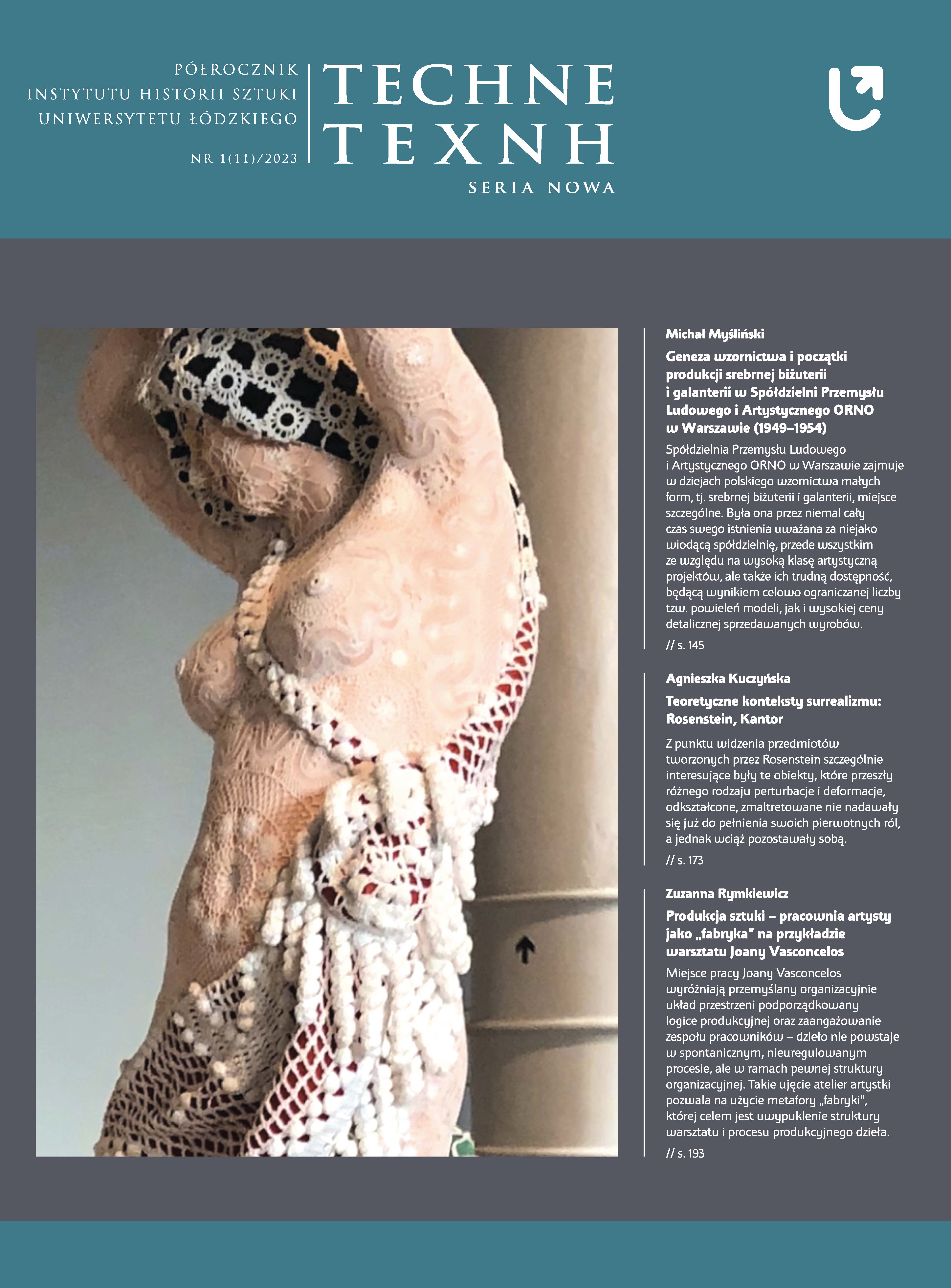Panorama studiów nad wzornikami hafciarskimi w Meksyku
DOI:
https://doi.org/10.18778/2084-851X.15.05Słowa kluczowe:
wzorniki hafciarskie, sztuka kobiet, Meksyk, sztuka hafciarskaAbstrakt
W Meksyku, przede wszystkim w ciągu XIX wieku, opracowywanie wzorów hafciarskich było zajęciem bardzo popularnym wśród młodych dziewcząt. Powstawały obiekty, które ukazywały powtarzalność pewnych ornamentów i sposobów wykonania, i stawały się wzornikami demonstrującymi rodzaje technik hafciarskich. Tkaniny te były już przedmiotem wielu studiów, szczególnie w ujęciu historycznym, etnograficznym, archeologicznym czy związanym z konserwacją dzieł sztuki. Pozwoliło to na wyodrębnienie głównych koncepcji, które miały wpływ na wytyczenie schematów determinujących dotychczasowe podejście do tematu. W prezentowanym artykule dokonano przeglądu różnych koncepcji badań, które ukształtowały refleksję dotyczącą wzorników hafciarskich w Meksyku, uwzględniono także studia zagraniczne. Zostało również zaproponowane ujęcie z zakresu historii sztuki, pozwalające na nowe ustalenia i możliwości analizowania tych obiektów będących elementami kultury materialnej. Kobiety, które zajmowały się opracowywaniem wzorników, można postrzegać jako artystki, mistrzynie swego fachu, których wirtuozeria przejawiała się w klasie samych obiektów będących rezultatem poświęconego czasu i niezwykłej sprawności manualnej.
Bibliografia
American needlework 2000–2015 – American needlework in the Eighteenth Century, The Metropolitan Museum of Art, Estados Unidos de América, 2000–2015, http://www.metmuseum.org/toah/hd/need/hd_need.htm [dostęp: 25.03.2015].
Google Scholar
ARMELLA DE ASPE/TOVAR 1992 – Virginia Armella de Aspe, Guillermo Tovar de Teresa, Bordados y Bordadores, México 1992.
Google Scholar
ARREDONDO 2003 – María Adelina Arredondo, Obedecer, servir y resistir: la educación de las mujeres en la historia de México, México 2003.
Google Scholar
BROWNE/WEARDEN 2010 [1999] – Clare Browne, Jennifer Wearden, Samplers from the Victoria and Albert Museum, London 2010 [1999].
Google Scholar
COVARRUBIAS HOROZCO 1611 – Sebastián Covarrubias Horozco, Tesoro de la lengua castellana o española, Madrid 1611, http://fondosdigitales.us.es/fondos/libros/765/637/tesoro-de-la-lengua-castellana-o-espanola/ [dostęp: 25.03.2015].
Google Scholar
DE ÁVILA 2014 – Alejandro de Ávila, In octacatl, in machiyōtl: dechados de virtud y entereza, Museo Textil de Oaxaca, México 2014, http://www.museotextildeoaxaca.org.mx/expodet.php?ie=120 [dostęp: 24.04.2015].
Google Scholar
Diccionario de autoridades 1732 – Diccionario de Autoridades, vol. III, Madrid 1732, http://web.frl.es/DA.html [dostęp: 14.05.2015].
Google Scholar
Don Quijote 2005 – Don Quijote en el campus: tesoros complutenses, Madrid 2005, http://biblioteca.ucm.es/foa/exposiciones/15Quijote/ [dostęp: 15.05.2015].
Google Scholar
FLORES ENRÍQUEZ 2014 – Mayela Flores Enríquez, Dechado Mexicano / Mexikanisches Stickmuster, „Miradas” 2014, nr 1, s. 146–150, http://dx.doi.org/10.11588/mira.2014.0.16750 [dostęp: 15.03.2015].
Google Scholar
GÓMEZ CANEDO 1928 – Lino Gómez Canedo, La educación de los marginados durante la época colonial. Escuelas y colegios para indios y mestizos en la Nueva España, México 1928.
Google Scholar
GONZÁLEZ MENA 1994 – María Ángeles González Mena, Colección pedagógico textil de la Universidad Complutense de Madrid: estudio e inventario, Madrid 1994.
Google Scholar
HERNÁNDEZ RAMÍREZ/PAVÍA MILLER/GARCÍA GONZÁLEZ 1995 – María Hernández Ramírez, María Teresa Pavía Miller, Laura García González, Colección de dechados del Museo Nacional de Historia, México 1995.
Google Scholar
LEÓN-SOTELO Y AMAT 2010 – María Teresa León Sotelo y Amat, Aprender a escribir bordando, Madrid 2010, http://www.bne.es/es/Actividades/Ciclos/PiezaDelMes/Historico/piezas2010/confepiezamesfebr.html [dostęp: 26.04.2015].
Google Scholar
Los dechados 1996 – Los dechados, una tradición extinta, „México en el tiempo”, México Desconocido, nr 15, octubre–noviembre 1996.
Google Scholar
MURIEL 2005 – Josefina Muriel, La legislación educative para las niñas y doncellas del virreinato en la Nueva España, [w:] La sociedad novohispana y sus colegios de niñas. Fundaciones del siglo XVI, t. I, México 2005, s. 40.
Google Scholar
Needleprint 2009–2015 – Needleprint, 2009–2015, http://needleprint.blogspot.mx/ [dostęp: 20.05.2015].
Google Scholar
PARKER’S SAMPLER 2015 – Elizabeth Parker’s Sampler, Textiles from the Victoria and Albert Museum, Londres 2015, http://www.vam.ac.uk/content/articles/s/sampler/ [dostęp: 24.02.2015].
Google Scholar
SANDOVAL/FLORES 2015 – Juan Sandoval, Mayela Flores, Los dechados, México 2015, http://culturacolectiva.com/los-dechados/ [dostęp: 24.03.2015].
Google Scholar
SANTA TERESA DE JESÚS 1675 – Santa Teresa de Jesús, Obras de la Gloriosa Madre Santa Teresa de Jesús, fundadora de la reforma de la orden de Nuestra Señora del Carmen. Dedicadas a la Majestad católica de la Reina Nuestra Señora, Doña María Ana de Austria, Bruselas 1675.
Google Scholar
SEGURA LACOMBA 1949 – Segura Lacomba, Bordados populares españoles, Madrid 1949.
Google Scholar
STAPLEY 1924 – Mildred Stapley, Tejidos y bordados populares españoles, Madrid 1924.
Google Scholar
Textiles 2015 – Textiles, Victoria and Albert Museum, Londres 2015, http://www.vam.ac.uk/page/t/textiles/ [dostęp: 14.05.2015].
Google Scholar
TUROK WALLACE 1994 – Marta Turok Wallace, Dechados y textiles mexicanos en museos extranjeros, [w:] México en el mundo de las colecciones de arte. México Moderno, México 1994.
Google Scholar
FDFM – Fondo Franz Mayer, Acervos Documentales, Muso Franz Mayer.
Google Scholar
Pobrania
Opublikowane
Jak cytować
Numer
Dział
Licencja

Utwór dostępny jest na licencji Creative Commons Uznanie autorstwa – Użycie niekomercyjne – Bez utworów zależnych 4.0 Międzynarodowe.








